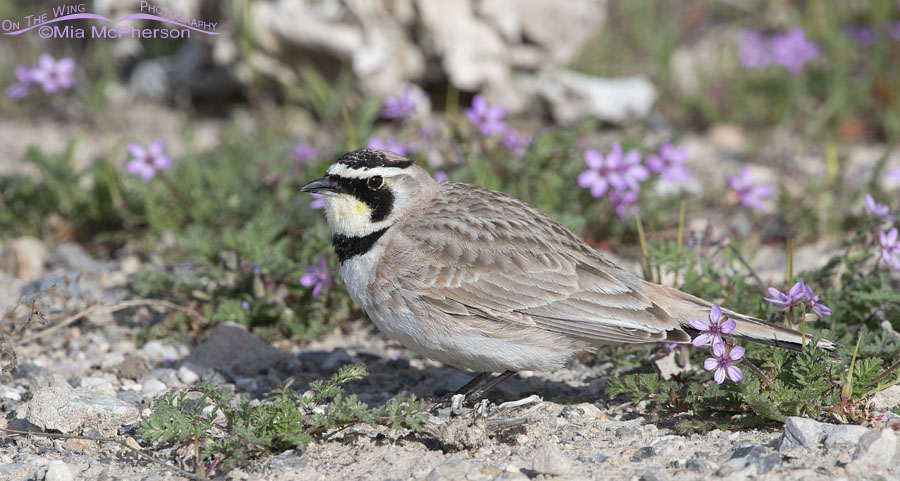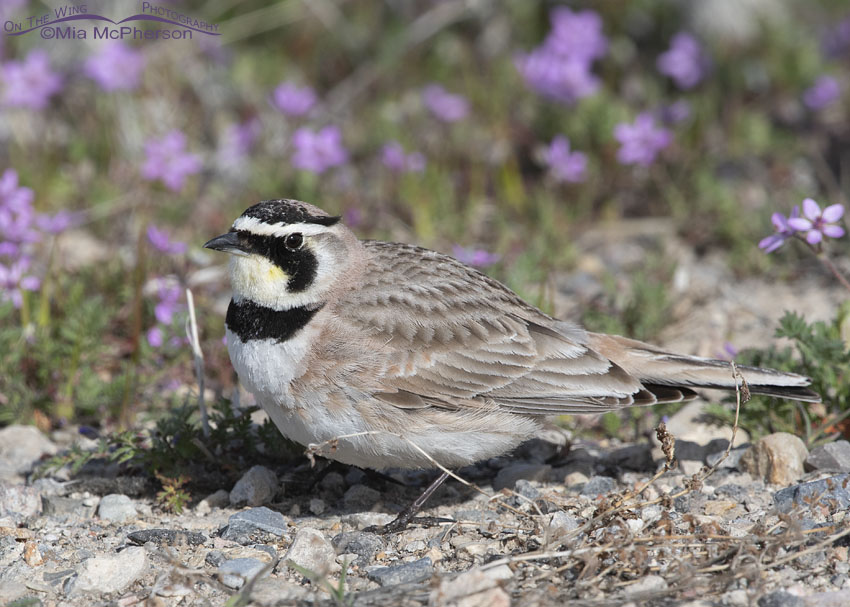 Horned Lark in Redstem Filaree – Nikon D500, f10, 1/800, ISO 400, Nikkor 500mm VR with 1.4x TC, natural light
Horned Lark in Redstem Filaree – Nikon D500, f10, 1/800, ISO 400, Nikkor 500mm VR with 1.4x TC, natural light
Birds by themselves are great, birds with wildflowers are even greater in my opinion and any time I have the opportunity to take bird & wildflower images I will jump at the chance. The wildflowers certainly add a punch of color to my bird photos when they are in bloom.
Redstem Filaree (Erodium cicutarium) is in full bloom right now here in northern Utah and they have even tinted the hillsides on Antelope Island a delicious shade of pinkish-purple because they are blooming so profusely. I have photographed Willets, Burrowing Owls and Chukars and I’m certain a few other species of birds that I can’t recall this morning which include Redstem Filaree in the frames.
Yesterday I had the opportunity to photograph a male Horned Lark on Antelope Island State Park that included Redstem Filaree in the photos and I was delighted, that pop of bright color sure says “spring” to me.
 Wildflowers and a Horned Lark – Nikon D500, f10, 1/800, ISO 400, Nikkor 500mm VR with 1.4x TC, natural light
Wildflowers and a Horned Lark – Nikon D500, f10, 1/800, ISO 400, Nikkor 500mm VR with 1.4x TC, natural light
Redstem Filaree is an introduced herbaceous annual (biennial in warmer climates) which has become invasive in deserts and arid grasslands, it is native to the Mediterranean Basin and was introduced in the 18th century. I’ve read that the entire plant is edible but I don’t think I will nibble on it myself. I don’t recall ever seeing a bird or animal on Antelope Island consuming it but I suspect that some of the birds there may eat the seeds after the plants are finished blooming and the seeds have set. These wildflowers are also called common stork’s-bill, redstem stork’s bill and heronsbill.
Whatever they are called the blooms of Redstem Filaree are always a welcome addition to my bird photos because the dainty flowers are so cheery and I think they add a touch of whimsy to my images.
As I have been writing this post this morning I have heard the wind start to howl loudly outside my window and I know that a storm front is moving in that will bring clouds, rain and perhaps the last snow of this winter. Old Man Winter seems reluctant to give up his hold but I know that Spring has arrived and I wonder what great birds will arrive after this storm moves on.
Life is good.
Mia


Once again…it’s all there. Wonderful detail and textures set against a beautiful background. Thanks Mia.
Aaaah.
Lovely things – both the flora and the fauna.
Thank you.
I love the sound of that plant’s name…Redstdm Filaree….it’s fun just to say…the shots of the lark are beautiful, especially the second one. You say it’s Spring, the calendar says so, too…and the Redstem Filarees are blooming….so, maybe…….dare I hope???
Nice compositions! I was struck by how pale your Horned Lark is in comparison to those we see in NE Illinois. The flowers do make up for the lack of color in the bird!
Ken, I believe I recall that there are at least 21 subspecies of Horned Larks with the northeastern subspecies being the darkest, the Horned Larks in desert and southwestern areas all tend to be lighter. I saw and photographed one in southeastern Utah that had me stumped on the ID at first because it was much lighter than even those we have here in northern Utah. It took a few seconds for my head to wrap around the coloration and the rest of the key ID features.
Beautiful
Thanks Bob!
These are beautiful shots, Mia. I can sense your enthusiasm about the arrival of spring and the many photo opportunities that offers you, after a long winter, whereas in Chile, where I live, winter is already showing its first signs.
Thanks Ricardo. I often look forward to winter myself because of the birds we have here during the winter that we don’t have in the warmer months but the length of winter here is sometimes a bit much!